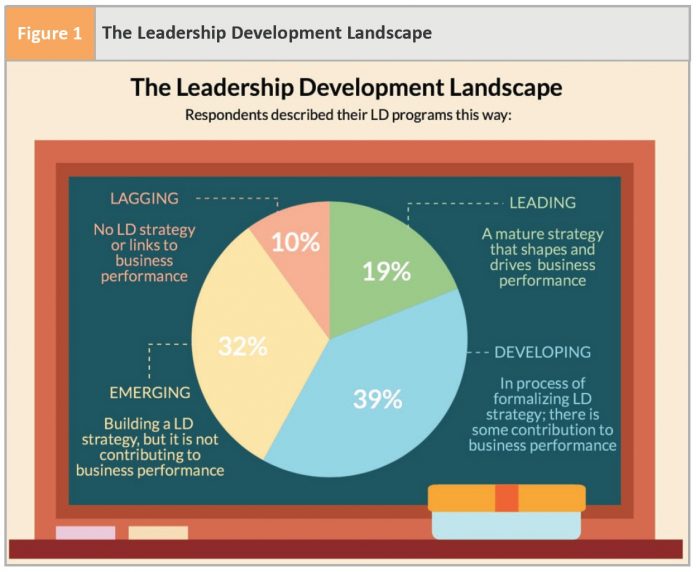
Each year, leadership development (LD) sits atop the list of Human Capital Management priorities—and disappointments. Overall, less than 40 percent of organizations participating in Brandon Hall Group’s annual Leadership Development research say their LD programs are effective, even while they plan to invest more time and money in 2017.
So why does leadership development have such a dysfunctional relationship between investment and success?
The answer can be summed up in one word: strategy.
Approximately 81 percent of organizations responding to the research survey have less than a mature strategy that does not drive business performance. Among those organizations, between 21 percent and 39 percent believe their leadership development programs are effective (depending on the leadership levels).
But for the 19 percent that describe themselves as “Leading” organizations with a mature strategy that drives business performance, results are dramatically better: Those rating LD as effective or very effective range from 59 percent to 93 percent, depending on the leadership levels. A mature strategy includes a well-developed framework and critical leadership competencies that are aligned with business objectives.
Only one-tenth of organizations describe themselves as “Lagging,” meaning they do not have any LD strategy or linkage of LD to business performance. That is an improvement of more than 60 percent compared with our 2014 Leadership Development Study. However, a majority of organizations (71 percent) still are in various stages—“Emerging” or “Developing”—of crafting a LD strategy (see Figure 1 below). They are not at the point where their LD programs are having a significant impact on business performance.
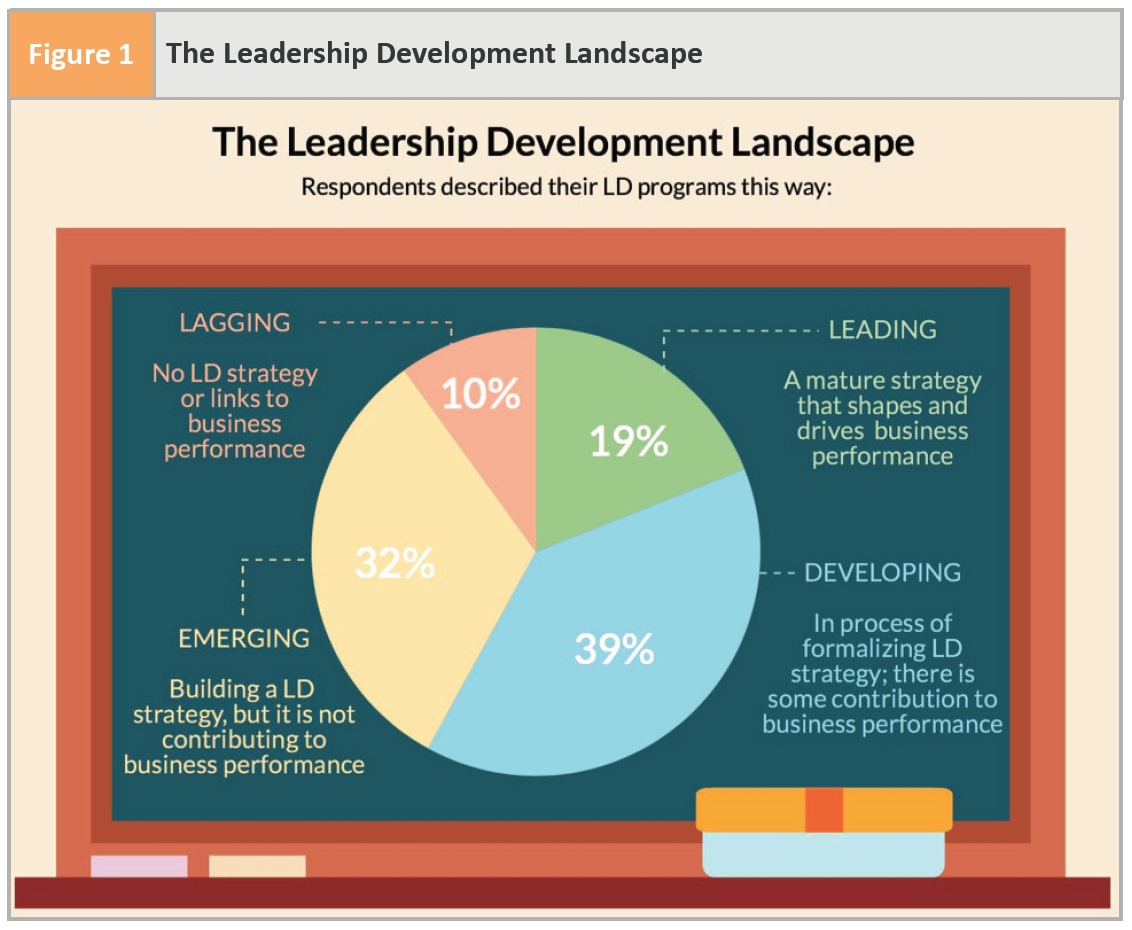
Source: 2016 Brandon Hall Group Leadership Development Study (n=275)
However, the 19 percent of respondents that describe themselves as “Leading” organizations, which have a mature strategy that shapes and drives business performance, are having the kind of success one would expect from the large investment most organizations are making, including:
- A reduced leadership gap. Some 49 percent of Leading organizations say they have a leadership gap—a rate that is 64 percent less than that of all other organizations.
- A significant impact on the bottom line. Some 51 percent of Leading organizations say their LD programs contribute to the business bottom line, almost three times more than the remaining organizations.
- Strong alignment between the LD program and business objectives. Some 82 percent of Leading organizations tie LD directly to business objectives—58 percent more than all other organizations.
Figure 2 (below) illustrates the distinct difference between “Leading” organizations and everyone else related to our Leadership Development Effectiveness Indicators.
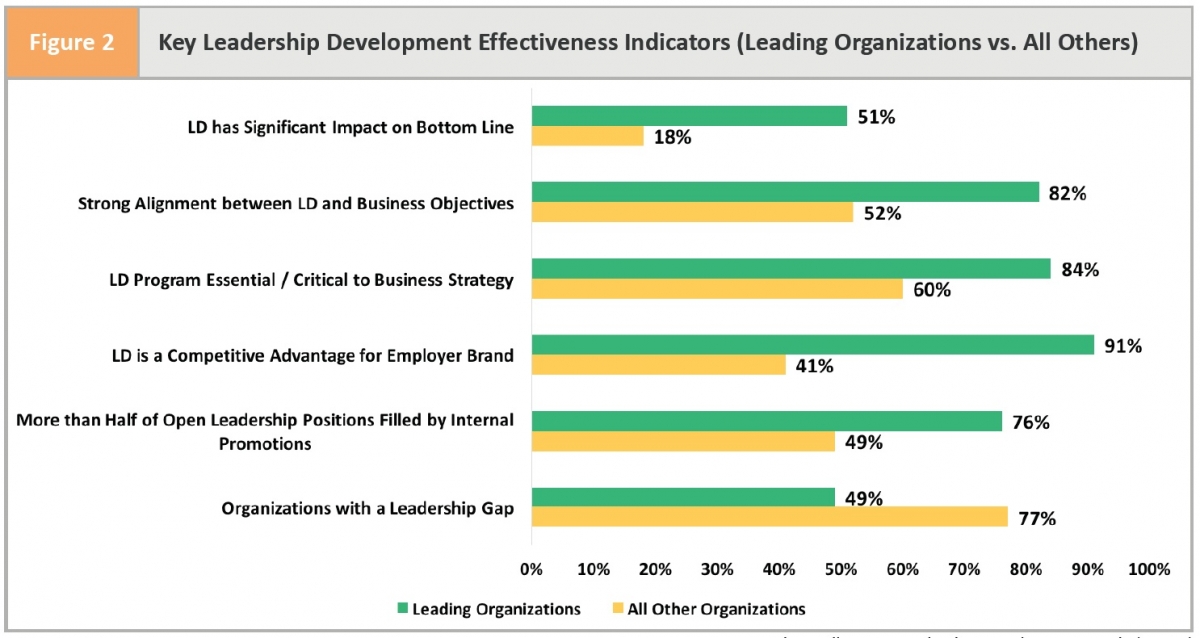
Source: 2016 Brandon Hall Group Leadership Development Study (n=295)
Like most organizations in our study, Leading organizations face significant obstacles—mostly in the form of time and resources—in creating an effective leadership development program. The difference between Leading and other organizations appears to be that they have used their limited time and resources to develop a strategy—or playbook—on how to approach LD. Based on our research and preliminary interviews with selected respondents, which are still in progress as this summary report is written, the critical components of the strategies appear to be three-fold:
- A set of leadership competencies, linked to business objectives, for the organization overall.
- A focus on specific competencies, still linked to business goals, at each leader level—such as high potentials, future or emerging leaders, supervisors, mid-level managers, senior management, and executive management.
- An understanding that the approaches to LD should change based on the skills, competencies, and level of individuals being developed. For instance, some skills are best addressed in an instructor-led classroom, while others are best taught through different modalities (coaching, on-the-job training, action learning, stretch assignments, etc.).
In other words, LD programs are more effective if built from a core philosophy—backed by specific competencies—that reflects the complexity of the business, the differences between leader levels, and the diversity of skills and backgrounds among the leaders being developed.
This article will provide key findings of the research and their impact on the leadership development process. The research, conducted in October and November, includes 295 usable responses in 28 countries and 33 industries.
Analysis of Top Findings
1. There is a strong correlation between a mature leadership development strategy and the effectiveness of leadership development programs.
Overall, our 2016 research showed some progress in how organizations are approaching leadership development. More organizations have developed leadership competencies, for instance, and LD programs have less focus on classroom learning than just a few years ago. However, Leading organizations (those with a mature LD strategy) are the only ones that are achieving high degrees of effectiveness.
Our survey divided LD into six categories: executive management, senior management, mid-level management, supervisors, high potentials, and future/emerging leaders. Overall, only the mid-level management and supervisor levels had more than 40 percent of organizations saying the LD was effective or highly effective.
But when we looked at the results of Leading organizations compared with Developing, Emerging, and Lagging organizations combined, the results were startling: Over the six levels, an average of 74 percent of Leading organizations ranked LD as effective/highly effective, while all the other organizations averaged 28 percent effective/highly effective.
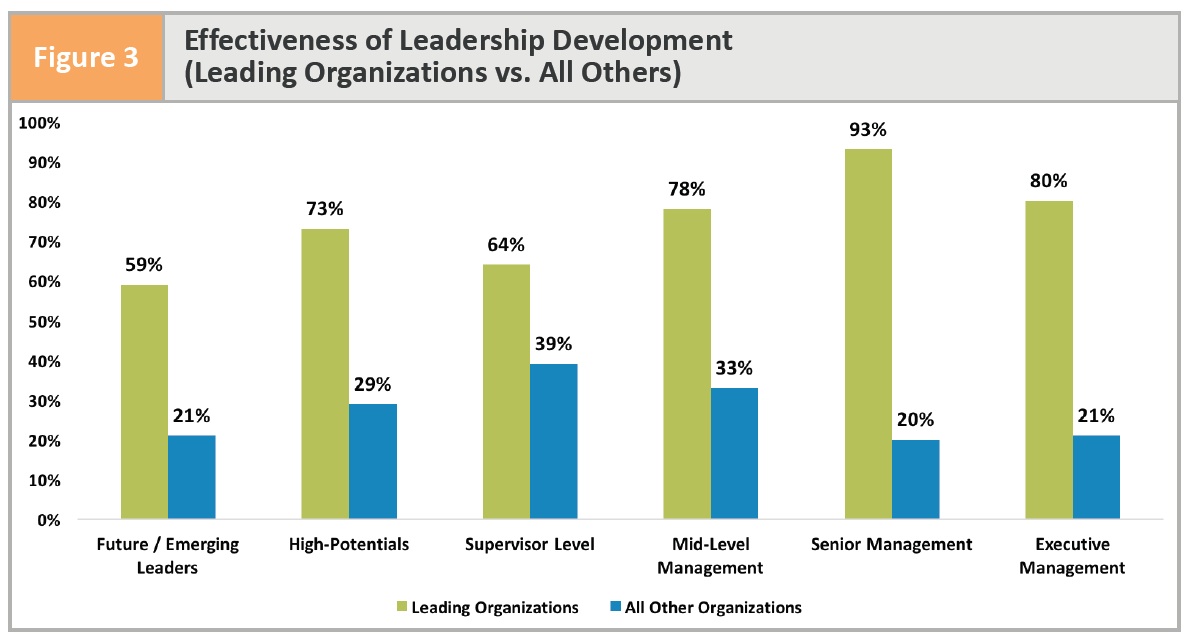
Source: 2016 Brandon Hall Group Leadership Development Study (N=295)
This finding is important because it shows that even organizations that are making progress in developing a strategic, disciplined approach to LD do not get strong results until the strategy is fully developed and executed. This indicates that organizations in the Emerging and Developing levels would be wise to finish deploying their strategies as their next priority in the evolution of leadership development. There is always pressure to roll out more initiatives and train more leaders, but making sure in the short run that the programs are structured properly based on leadership competencies and business objectives will make LD much more effective in the long run.
2. Time and resources are overwhelmingly seen as the biggest barriers to an effective leadership development program.
A well-developed LD strategy enables organizations to efficiently and effectively put together programs at all leader levels to deliver on business objectives. Having a clear direction is important, because our research shows that organizations do not have the money nor the resources to waste.
As Figure 4 below illustrates, time and resources are the biggest barriers to effective leadership development. Time constraints are by far the biggest barrier, followed by financial resources, lack of resources to design and implement programs, and the inability to measure impact.
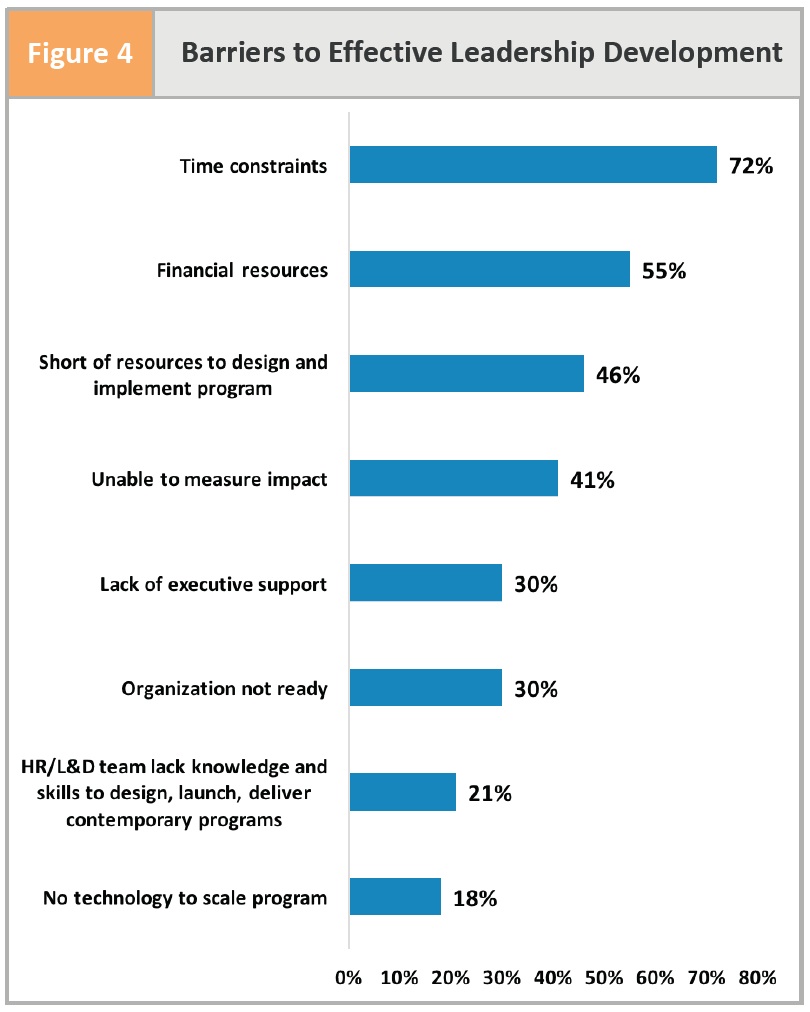
Source: 2016 Brandon Hall Group Leadership Development Study (n=272)
Interestingly, Leading organizations cite largely the same barriers, but in slightly smaller numbers. The biggest difference in barriers is lack of organizational readiness, which is more than twice as prevalent in lower-performing organizations (Lagging, Emerging, Developing) than in Leading organizations. Lack of executive support also is cited 43 percent more often among the lower-performing organizations. This illustrates the importance of a mature strategy because it is hard to have one without executive support or the organization being ready.
These statistics also raise the question of how serious organizations really are about LD. Some 65 percent of organizations say LD is essential or critical to their business strategy. It would figure then, that organizations also are putting time and money into it, but the research indicates other priorities are getting in the way.
3. Modalities used for LD vary considerably between leader levels, indicating that more organizations are taking a more thoughtful and strategic approach to developing leaders.
Four years ago, when we launched our annual leadership development studies, 87 percent of organizations used classroom learning, and no other modality was within 20 percentage points. In the 2015 study, on-the-job training was a relatively close second to classroom learning in use, but coaching and mentoring still lagged far behind, though effectiveness ratings for coaching, on-the-job training, and assessments were within 5 percent of classroom learning.
As we head into 2017, it’s a whole new world.
In terms of use, classroom ranks first only among mid-level managers/supervisors—and even then, it is tied with microlearning, which was not even part of the LD lexicon three years ago. Classroom learning is still widely used—as it should be, in the right circumstances—but this data shows that organizations are taking a much more strategic and eclectic approach to training leaders, which is a sign of real progress.
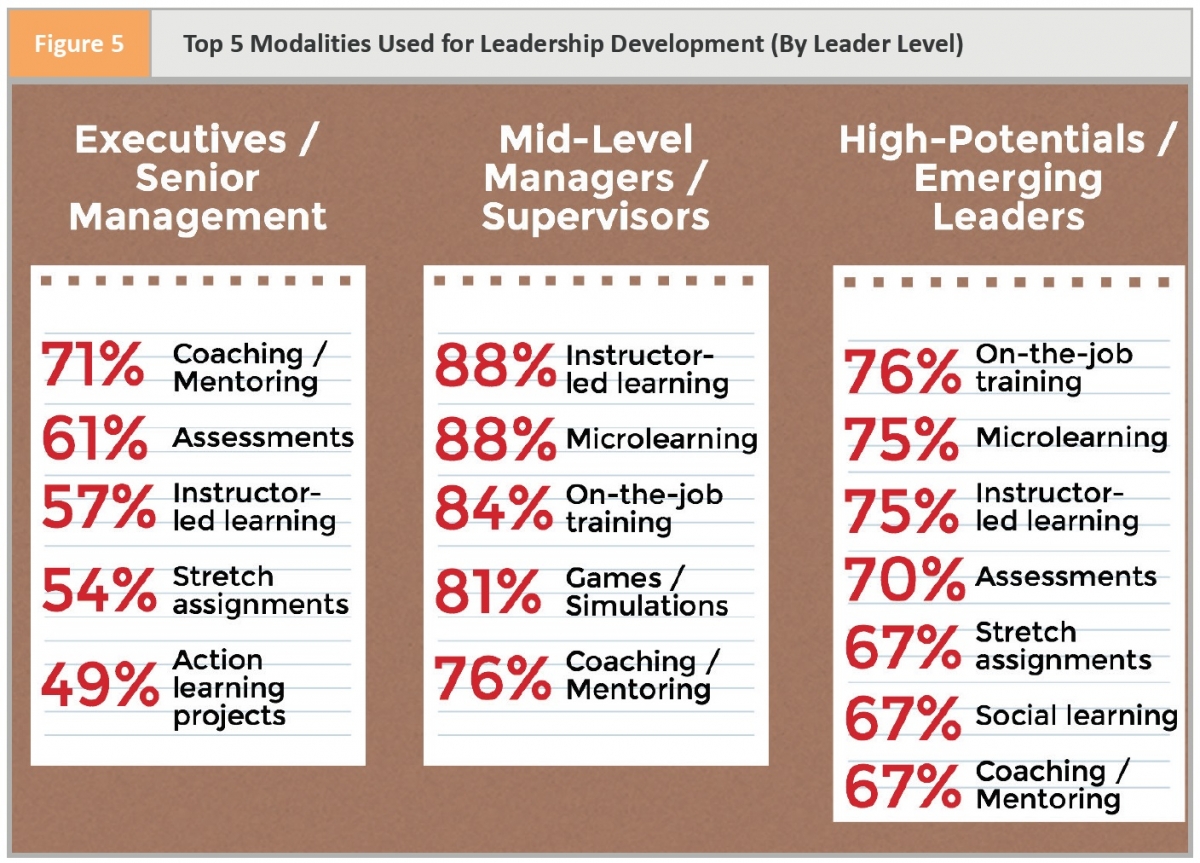
Source: 2016 Brandon Hall Group Leadership Development Study (n=232)
There also has been a big change in how organizations see the effectiveness of modalities. What stands out is that the top six modalities are grouped within 16 percentage points of each other, whereas two years ago, there was a great chasm in effectiveness between classroom and almost all other modalities. Organizations have taken the steps to try other modalities in certain situations and are finding they all can be effective in the right situations. This is real progress, and bodes well for effectiveness results in the years ahead.
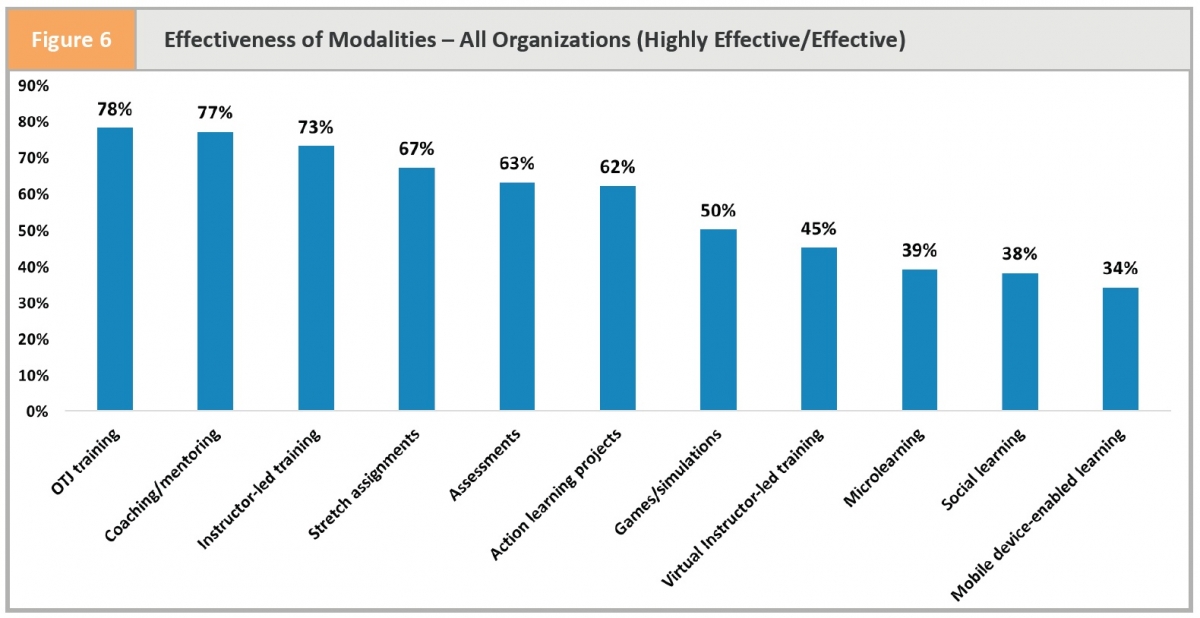
Source: 2016 Brandon Hall Group Leadership Development Study (n=230)
4. Organizations with mature strategies are more focused on competencies and metrics that are tied to business goals.
Leading organizations are more than three times more likely to see LD as having an impact on the bottom line, and 58 percent more likely to have LD strongly aligned with business objectives. We get a better understanding of why when comparing critical leadership competencies and metrics used to measure leadership effectiveness.
Among lower-performing organizations—those in the Lagging, Emerging, and Developing levels—the most critical competencies are Results Oriented (76 percent) and Strategic Thinking (69 percent), followed by Effective Communicator (61 percent) and Teambuilder (59 percent). These are among the top competencies for Leading organizations, as well, but a much higher percentage of organizations focus on Teambuilder (84 percent), Strategic Thinking (82 percent), Effective Communicator (68 percent), and other competencies such as Coaching/Mentoring (73 percent to 58 percent) and Trust Building (61 percent to 44 percent). Teambuilding is particularly telling because it is hard to get real business results unless the organization is working well together for a common purpose. Leading organizations are 42 percent more likely to do that than other organizations.

Source: 2016 Brandon Hall Group Leadership Study (n=246)
Most organizations are focusing on pre-requisites to outstanding leadership—i.e., being results oriented and being a strategic thinker. Leading organizations, while embracing those competencies, are more focused on competencies that have more impact on results—teambuilding, coaching, mentoring, and trust building among them.
Similar dynamics exist when looking at how LD effectiveness is measured. Most organizations are most heavily focused on improving leadership skills and improving employee engagement, which are important building blocks toward improving business performance. But Leading organizations are much more focused than their counterparts on measuring impact, such as retention of leaders (80 percent vs. 48 percent), development of high potentials (76 percent vs. 39 percent), pool of future leaders (62 percent vs. 40 percent), and business objectives achieved (58 percent vs. 41 percent).
Looking at these results, one begins to get a good understanding why Leading organizations see better results, get more open leadership positions filled internally, see LD as a competitive advantage for the employer brand, and see LD as being more essential to business strategy.
Claude Werder is vice president of Research Operations and principal analyst for Brandon Hall Group, a leading independent research/analyst firm covering Human Capital Management. The firm has practices in Learning & Development, Leadership Development, Talent Management, Talent Acquisition, and HR/Workforce Management. The firm also produces the global Brandon Hall Group Excellence Awards and hosts Excellence Conference17 Jan. 24-27 in Palm Beach Gardens, FL.




